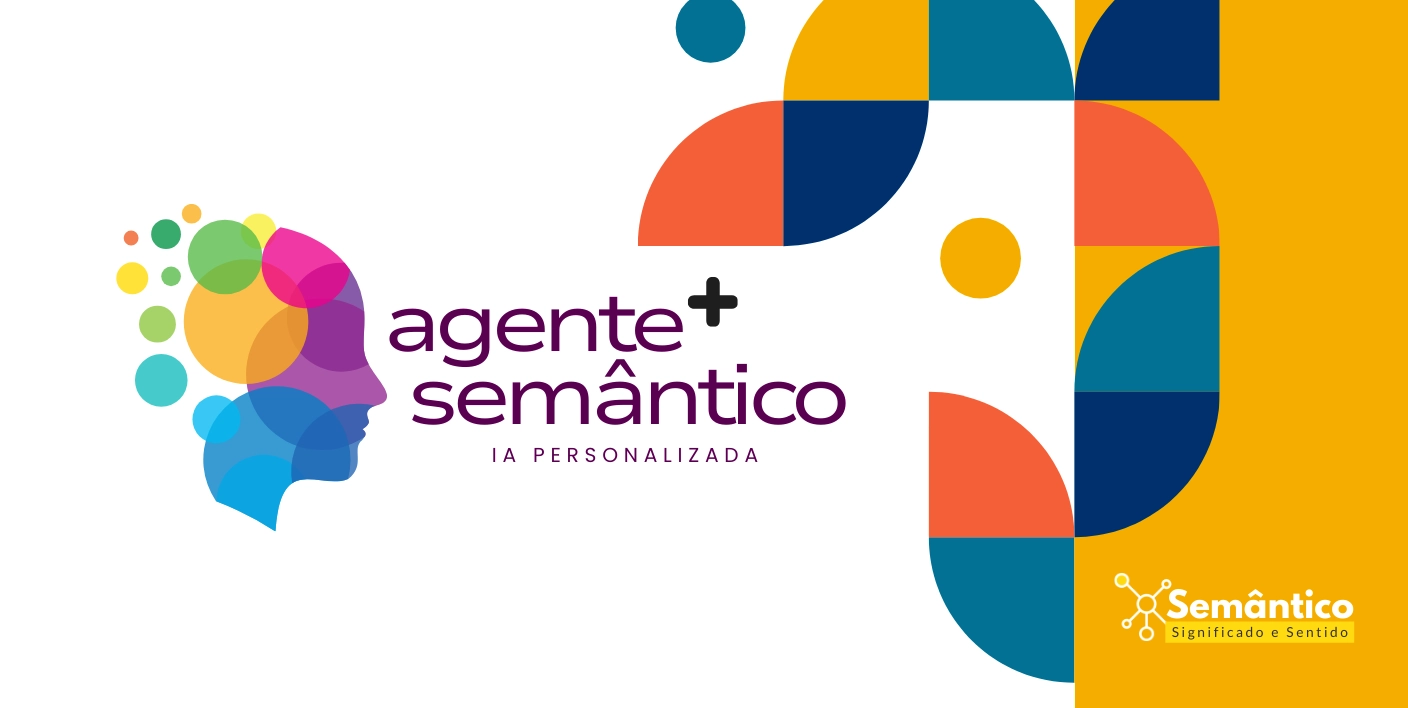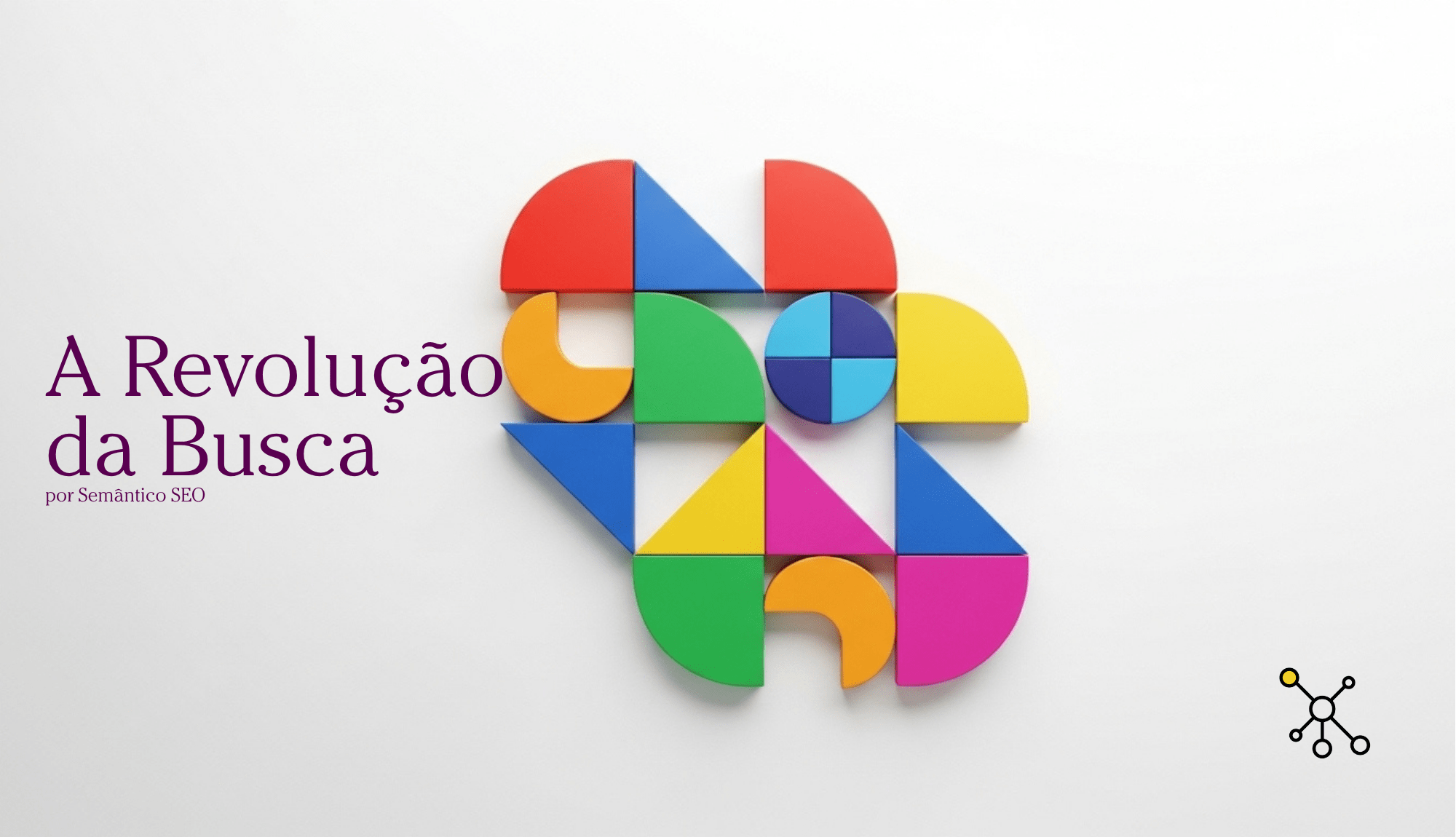A Revolução da Busca
O SEO, coitado, tem passado por poucas e boas desde que nasceu. Já morreu e renasceu tantas vezes, já mudaram ele de nome algumas vezes e continua aqui. Na prática, otimizar processos não foi inventado pelos pioneiros que viram aquela ferramenta de busca chamada Google funcionando pela primeira vez.
Neste nosso mundo novo, tão dinâmico e intrincado, esse vasto tecido orgânico e digital contemporâneo, a otimização para ferramentas de busca, também conhecida Search Engine Optimization, transcendeu em essência. Desde a mera manipulação de palavras-chave, com foco em manipular o sistema de buscas e conquistar as primeiras posições nos resultados, até hoje, tomados pelo pavor de não saber o que fazer para ser citado pelo ChatGPT, a nossa função continua sendo entender como uma ferramenta de busca funciona. Depois o trabalho é formatar a informação que temos para que ela seja recuperada nessas ferramentas (ou se torne fonte para gerar uma resposta).
Sendo purista, qualquer sistema que oferece uma funcionalidade de busca: o Google, um buscador interno de um e-commerce ou até mesmo assistentes virtuais, é, por definição, uma ferramenta de busca. Portanto o ato de otimizar, ou criar conteúdo otimizado, que se manifesta como informação, dados ou qualquer outra representação, para que esses sistemas entreguem respostas de forma eficaz, seja recuperando ou gerando informação, permanece sendo SEO em sua raiz.
Quem me segue no Linkedin sabe a minha opinião sobre esta emergência de novas siglas para descrever esta atividade. Mas esse texto não é sobre isso. É algo bem mais técnico, mas que compõe o meu entendimento atual sobre o novo cenário da busca e eu estou compartilhando meus pensamentos sobre isso.

Dados vetoriais ajudam a redefinir o SEO Semântico?
Eu escrevi este artigo porque resolvi entender essa transformação que está remodelando a forma como interagimos com a informação online. Para nós, profissionais de SEO, e para qualquer indivíduo imerso no fluxo digital, compreender esses conceitos é uma forma de decifrar as complexidades do presente e as direções do futuro.
Mas o que é dado vetorial?
Dados vetoriais são representações numéricas de objetos, conceitos ou palavras, expressos como pontos em um espaço multidimensional. No estudo de busca semântica e aplicações de Inteligência Artificial (IA), esses vetores capturam as características essenciais e as relações semânticas dos dados originais, que podem ser palavras, imagens, vídeos ou áudios. Cada dimensão do vetor corresponde a uma característica específica, e a proximidade entre dois vetores nesse espaço indica a similaridade semântica entre os itens que eles representam. Essa capacidade de quantificar a similaridade torna os dados vetoriais fundamentais para a IA, especialmente em tarefas que exigem compreensão de contexto e significado.
Aplicações em busca semântica
Na busca semântica, dados vetoriais, frequentemente gerados por modelos de embedding (incorporação), permitem que os sistemas compreendam o significado por trás das consultas, em vez de apenas corresponder palavras-chave exatas. Por exemplo, uma consulta como “filmes de ficção científica sobre o espaço” pode ser convertida em um vetor que é semanticamente próximo a vetores que representam filmes como “2001: Uma Odisseia no Espaço” ou “Interestelar”, mesmo que as palavras exatas não estejam presentes nos títulos. Isso aprimora significativamente a relevância dos resultados de busca, proporcionando uma experiência mais intuitiva e eficaz para o usuário.
Aplicações em Inteligência Artificial
Em aplicações de Inteligência Artificial, os dados vetoriais são a espinha dorsal de muitos algoritmos de aprendizado de máquina. Eles são usados em processamento de linguagem natural (PLN) para representar palavras e frases, permitindo que modelos compreendam e gerem texto. Em visão computacional, imagens e seus recursos são transformados em vetores para tarefas como reconhecimento facial e classificação de objetos. Além disso, sistemas de recomendação utilizam dados vetoriais para identificar padrões de preferência e sugerir itens relevantes, enquanto a detecção de anomalias pode encontrar padrões incomuns em grandes conjuntos de dados representados vetorialmente. A capacidade de representar informações complexas de forma padronizada e computável é o que torna os dados vetoriais uma ferramenta indispensável no cenário atual da IA.
A lacuna semântica e o desafio da busca tradicional
Historicamente, a maneira como os computadores armazenam e processam dados é muito diferente da forma como os seres humanos atribuem significado à informação. Bases de dados convencionais operam com campos estruturados, onde a informação é categorizada por formato de arquivo, data de criação ou tags inseridas manualmente. Embora isso seja eficaz para estruturar esses dados, essa abordagem gera alguns problemas graves quando se trata de capturar o contexto global de dados não estruturados, como imagens, textos e áudios. E imagine qual é a quantidade de dados não estruturados versus a de dados estruturados postados na internet todos os dias?
Esta desconexão gera o que o universo da tecnologia denomina de “lacuna semântica”: uma barreira entre o armazenamento computacional de dados e a compreensão humana de seu significado inerente.
Imagine ter uma vasta biblioteca organizada por tamanho de livro, mas sem um sistema que conecte os livros por seus temas ou conteúdos, tornando a busca por algo relevante uma tarefa árdua e muitas vezes improdutiva, se não, impossível.
Como preencher esta lacuna e revelar o significado?
É nesse ponto que os bancos de dados vetoriais surgem como uma solução salvadora? Não, mas que podem nos ajudar muito a resolver diversos problemas.
Diferente de seus predecessores, os bancos de dados relacionais, eles foram criados para armazenar e recuperar dados sob a forma de “embeddings vetoriais”, ou seja, arranjos de números. O aspecto principal desses vetores é que eles codificam a “essência semântica” da informação. Em outras palavras, itens que possuem significados semelhantes são posicionados de forma próxima no espaço vetorial, enquanto itens dissimilares são distanciados.
Visualização do Espaço Vetorial Semântico

Conforme discutido, bancos de dados vetoriais armazenam informações como “embeddings vetoriais” – arranjos de números que codificam a “essência semântica” dos dados. Nesta visualização simplificada de um espaço 2D, você pode ver como itens com significados semelhantes (por exemplo, “Maçã (fruta)” e “Laranja”) são posicionados próximos uns dos outros, formando clusters semânticos. Em contraste, itens com significados distintos (como “Maçã (fruta)” e “Apple (empresa)”) estão mais distantes, demonstrando a relação de proximidade e distância baseada no significado.
Essa capacidade de representar o significado permite a realização de buscas por similaridade que transcendem a correspondência exata de termos. Todos que usam um buscador atual sabe que é possível pesquisar por conteúdo que seja semanticamente parecido, mesmo que as palavras não sejam idênticos.
Imagine buscar por “imagens com paletas de cores semelhantes a um pôr do sol nas montanhas” ou “paisagens com atributos parecidos”, se a sua busca for semântica ou híbrida, a chance do resultado ser bom é muito maior. E os bancos de dados vetoriais tornam isso uma realidade tangível, através de operações matemáticas que identificam vetores próximos uns dos outros no espaço multidimensional.
Embeddings vetoriais, seus modelos e dimensões
A criação desses vetores que capturam o significado é um processo complexo, complicado de entender, mas fascinante. Os embeddings vetoriais são gerados por “modelos de embedding” (ou modelos de incorporação) que são treinados em vastos conjuntos de dados. No início do boom da Inteligência Artificial esses modelos eram treinados com trilhões de textos, um corpus de texto. Hoje em dia com a busca multimodal temos texto, imagem, vídeo e áudio fazendo parte desse gigantesco “banco de dados”, por isso o nome Large Language Model.
A diversidade de dados exige modelos especializados: por exemplo, o modelo CLIP é importante para imagens, o Glove para texto e o Wave to Vec para áudio.
Quando um dado não estruturado, seja uma imagem, um trecho de texto ou um arquivo de áudio, é processado por um modelo de embedding, ele passa por múltiplas camadas de tratamento. Cada camada tem a capacidade de extrair características cada vez mais abstratas:
- Para uma imagem, as camadas iniciais podem identificar bordas e texturas, enquanto as camadas mais profundas reconhecem objetos e cenas completas.
- No caso do texto, as primeiras camadas processam palavras individuais, e as subsequentes compreendem o contexto e o significado global.
O resultado final é um vetor de alta dimensionalidade (podendo ter centenas ou milhares de dimensões) que encapsula as características essenciais da entrada, representando o significado de forma matematicamente comparável.
A eficiência na busca: indexação vetorial e algoritmos ANN
Com milhões, ou até bilhões, de vetores de alta dimensionalidade em um banco de dados, comparar um vetor de consulta com cada vetor existente seria uma tarefa proibitivamente lenta e progressivamente cara. Para superar essa limitação, a “indexação vetorial” emprega algoritmos de Approximate Nearest Neighbor (ANN), ou Vizinhança Mais Próxima Aproximada.
Os algoritmos ANN sacrificam uma pequena parcela da precisão em favor de uma velocidade substancialmente maior de busca. Em vez de encontrar a correspondência exata mais próxima, eles localizam rapidamente os vetores que são muito prováveis de estarem entre os mais próximos, tornando a busca por similaridade em grandes volumes de dados extremamente eficiente.
É por esse fator que podemos afirmar, com um certo grau de adaptação, que um modelo generativo está sempre trabalhando na média.
Exemplos notáveis de métodos de indexação incluem o HNSW (Hierarchical Navigable Small World), que constrói grafos multicamadas, e o IVF (Inverted File Index), que segmenta o espaço vetorial em clusters. Essa eficiência é uma das bases para o desempenho das aplicações de IA e da busca semântica em larga escala, por conta disso temos respostas muito rápidas para perguntas cada vez mais complexas.
RAG e a evolução da busca semântica
Aplicações práticas dos bancos de dados vetoriais estão se tornando cada vez mais presentes, principalmente no campo da Inteligência Artificial aplicada. Um exemplo cada vez mais comum é o RAG ou Retrieval Augmented Generation.
RAG é uma arquitetura de Inteligência Artificial que combina a capacidade dos Grandes Modelos de Linguagem (LLMs) de gerar texto com a habilidade de sistemas de recuperação de informação de buscar dados relevantes de fontes externas. Em essência, o RAG permite que os LLMs vão além de seu conhecimento pré-treinado, acessando e incorporando informações atualizadas e específicas do domínio antes de formular uma resposta. Isso ajuda a limitar problemas inerentes aos LLMs tradicionais: a tendência a “alucinar” (gerar informações incorretas ou inventadas) e a dependência de dados estáticos e potencialmente desatualizados.
Como funciona o RAG?
O processo do RAG geralmente envolve duas fases principais:
- Recuperação (Retrieval): quando uma consulta é feita ao sistema RAG, um componente de recuperação é ativado. Este componente busca em uma base de conhecimento externa (que pode ser um banco de dados, documentos internos da empresa, a internet, etc.) por informações que sejam semanticamente relevantes para a consulta do usuário. Essa busca geralmente utiliza técnicas de busca semântica, onde a consulta e os documentos são representados como vetores (dados vetoriais) em um espaço multidimensional, e a proximidade vetorial indica relevância.
- Geração (Generation): As informações mais relevantes recuperadas na fase anterior são então fornecidas ao LLM juntamente com a consulta original do usuário. O LLM utiliza esse contexto adicional, ou seja, as informações “aumentadas”, para gerar uma resposta mais precisa, factual e contextualizada. Isso garante que a saída do modelo seja fundamentada em dados verificáveis, em vez de depender apenas da memória interna do modelo adquirida durante o treinamento.
Então com o deu para perceber, neste contexto, os bancos de dados vetoriais armazenam fragmentos de documentos, artigos e bases de conhecimento como embeddings e ajudam os LLMs a gerar respostas melhores.
Quando um usuário formula uma questão, o sistema emprega a busca por similaridade vetorial para identificar os trechos de texto mais relevantes que se assemelham semanticamente à consulta. Esses fragmentos são então fornecidos ao modelo que os utiliza para formular respostas precisas e contextualmente informadas.
Para você me amigo que lê o Blog Semântico, e para todos os que buscam aprofundar seu entendimento sobre o novo cenário das buscas semânticas e impulsionadas por Inteligência Artificial, a compreensão desses conceitos é a porta de entrada para um novo mundo do SEO.
A busca semântica, que vai além da simples correspondência de palavras-chave, e a ascensão da Inteligência Artificial como um motor para a recuperação e geração de informação, são as forças que moldam o futuro da interação humana com o conhecimento? Vamos ver o que o futuro nos indica, mas tendemos para isso.
O objetivo principal da busca, desde suas origens, sempre foi conectar a necessidade informacional de uma pessoa à informação que a satisfaz. Essa premissa básica permanece inalterada. O que evolui, de forma incrível, é o “entre-meio”: as tecnologias e metodologias que tornam essa conexão cada vez mais fluida, intuitiva e precisa.
Bancos de dados vetoriais representam um avanço importante nesse sentido, e nós do SEO usamos as ferramentas onde eles estão presentes, sem saber o que está por trás. Mas esse modelo de banco de dados permite que as máquinas não apenas encontrem os dados e as transforme em informação, mas melhoram muito a compreensão e manipulação do significado intrínseco a eles.
Essa minha visão, fundamentada por quase duas décadas de trabalho neste campo, é que o SEO, em sua essência, não é apenas sobre otimizar para ferramentas de busca, mas sobre otimizar para a experiência humana de busca. Eu quero pensar que garantir que a informação, em sua plenitude de significado, seja descoberta, compreendida e utilizada pelas pessoas que precisam dela é o meu objetivo pessoal e profissional.
E nesse cenário, os bancos de dados vetoriais e a busca semântica são mais do que tendências tecnológicas; são a espinha dorsal de um futuro onde a informação se revela em sua forma mais rica e acessível.
Mas como será que esse cenário de uma busca semântica pode ser aplicado na prática, ou pelo menos em um exercício de imaginação do que seria uma aplicação? Eu tentei imaginar quatro cenários:
- descoberta do conhecimento (puxei a brasa para a pesquisa acadêmica);
- disseminação de notícias e informações;
- combate à desinformação;
- futuro da tecnologia de busca.
Por isso fiz mais pesquisas, contei com a ajuda do meu parceiro de pesquisas, o NotebookLM e tentei responder a essas perguntas. Vamos a elas:
Qual é o impacto da revolução da busca na pesquisa acadêmica e na descoberta de conhecimento?
A transição de uma busca baseada em palavras-chave para uma busca semântica, que utiliza dados vetoriais para compreender o significado e o contexto, tem o potencial de transformar a maneira como pesquisadores descobrem conhecimento. Isso já acontece hoje mas ainda não temos pesquisas demonstrando essa mudança.
Em vez de depender de combinações exatas de termos técnicos, um acadêmico poderia realizar buscas conceituais, encontrando estudos e artigos relevantes que abordam a mesma ideia, mesmo que com terminologias diferentes. Eu acabei de dizer para vocês que uso o NotebookLM do Google para fazer montar um ambiente de estudos e pesquisa, e também uso o Gemini na sua função Deep Research como o meu bibliotecário de referência particular para montar estratégias de buscas para mim.
O fato de eu ser estudante de biblioteconomia me ajuda a avaliar a qualidade da pesquisa que ele monta e poder personalizar, evitando equívocos.

Essa evolução tornaria o processo de revisão bibliográfica mais eficiente e abrangente? Talvez trabalhando em cojunto com o Retrieval Augmented Generation (RAG), que falei anteriormente. Essa combinação permitiria que os sistemas de IA consultassem as grandes bases de dados acadêmicas escolhidas pelos usuários, para gerar resumos, identificar conexões entre diferentes campos de estudo e responder a perguntas complexas de pesquisa.
Isso aceleraria a descoberta de conhecimento ao conectar informações de forma mais precisa e intuitiva, alinhando a necessidade informacional do pesquisador com os dados mais relevantes disponíveis.
Como a revolução da busca afetou a disseminação de notícias e informações?
Sabemos que a tecnologia altera fundamentalmente a disseminação de qualquer tipo de informação. Um das mudanças está em como a informação precisa ser estruturada para ser encontrada. Este novo momento exige que o conteúdo, incluindo notícias, seja formatado de uma maneira que as novas ferramentas de busca, como as que usam IA generativa, possam não apenas indexar, mas compreender e utilizar para construir respostas. Isso gera uma necessidade de um conhecimento técnico que a maioria dos profissionais não tem.
Isso significa que a visibilidade de uma notícia não dependerá mais apenas de técnicas de SEO tradicionais. A ênfase pode estar se deslocando para mais clareza, mais profundidade semântica e a confiabilidade do conteúdo. Portais de notícias que conseguirem apresentar suas informações de forma estruturada e rica em contexto terão maior probabilidade de serem usados como fonte pelas IAs generativas? Só o futuro nos dirá.
A disseminação se torna menos sobre “aparecer em primeiro” e mais sobre “ser a fonte da resposta”, mudando o paradigma de como a informação chega ao público. E temos muitos desafios nessa grande mudança, porque agora são as Big Techs, donas das ferramentas é que mandam no jogo.
Como a revolução da busca está impactando o combate à desinformação?
Os artigos que li como base deste artigo nos sugerem um caminho promissor para o combate à desinformação, centrado na arquitetura de IA conhecida como Retrieval Augmented Generation (RAG).
O grande problema das IAs generativas é a alucinação, ou seja, a criação de informações falsas, mas plausíveis. A desinformação prospera nesse ambiente. O modelo RAG impacta diretamente esse problema ao forçar a IA a basear suas respostas em informações recuperadas de uma base de dados externa e verificável, em vez de gerar texto livremente.
Este mecanismo funciona como um filtro de fatos. Antes de formular uma resposta, o sistema primeiro busca e recupera dados relevantes de fontes confiáveis. Somente com base nesses dados recuperados é que a IA gera a resposta final. Ao fundamentar a geração de conteúdo em fontes que podem ser auditadas e consideradas fidedignas, limita-se drasticamente o potencial de a IA inventar informações. Portanto, a revolução da busca, ao adotar essa arquitetura, aumenta a precisão e a factualidade das respostas, tornando-se uma ferramenta poderosa para mitigar a propagação de desinformação.
O uso de Grafos de Conhecimento em conjunto com ontologias pode ser um caminho para a construções de ferramentas RAG.
Quais são as previsões para o futuro da tecnologia de busca nos próximos 5 anos?
O futuro da busca nos próximos cinco anos será cada vez mais semântico e impulsionado por inteligência artificial, isso está claro para mim.
A busca por correspondência exata de palavras-chave já é obsoleta, e vai ter que ser substituída por sistemas que compreendem a necessidade, a intenção e o contexto por trás da consulta do usuário. Isso será possível graças à ampla adoção de tecnologias como os bancos de dados vetoriais que tratei neste artigo, que traduzem qualquer tipo de conteúdo em representações numéricas de seu significado, permitindo uma conexão muito mais precisa entre a dúvida e a resposta.
Além disso ferramentas de recuperação e geração de informação, ou agentes, treinados em assuntos muito específicos, orientados por grafos de conhecimento e ontologias especializadas devem ser o caminho para criar ferramentas muito impactantes na forma como buscamos informação no dia a dia.
Como consequência, a interação humana com o conhecimento se tornará mais fluida e intuitiva.
As barreiras entre a pergunta de uma pessoa e a informação que ela precisa serão reduzidas, com a tecnologia atuando como uma ponte quase invisível. Nesse cenário, o trabalho de SEO também evoluirá. A otimização não será sobre manipular algoritmos, mas sobre estruturar a informação da forma mais clara e compreensível possível para que as IAs possam descobri-la, validá-la e utilizá-la. A essência do SEO, de conectar pessoas à informação, permanecerá, mas as táticas serão focadas em otimizar a experiência humana de busca em um mundo movido por IA.
Eu agradeço a você que chegou até aqui em um conteúdo tão denso, eu espero ter lhe ajudado a entender melhor esse assunto. Estou lá no Linkedin à disposição para aprofundar esses assuntos. Continuemos nos falando, estudando, praticando e otimizando!





Publicar comentário